This was published 9 years ago
Top 10 changing of the guard ceremonies around the world
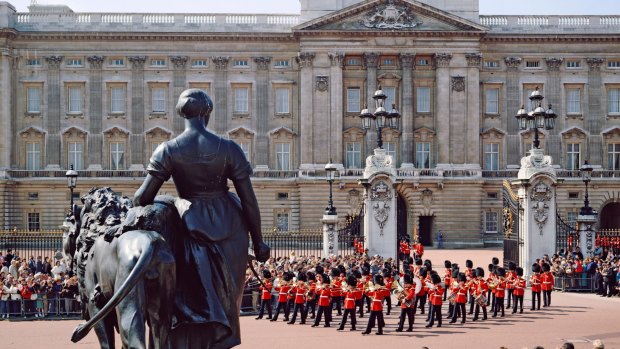
London: The Brits do military pomp at Buckingham Palace. Credit: Alamy
Whether it's the scarlet tunics of the Queen's Guard on parade at Buckingham Palace or Sweden's Royal Dragoons on their chargers at Stockholm's Royal Palace, the changing of the guard is one of the best free shows in town. When the military men – and women, in some cases – put on their dress uniforms, gleaming boots and shining armour and step out in perfect unison, it's a spectacle worth catching. Here are 10 of the best.
1. London, UK
Nobody does military pomp and circumstance better than the Brits, and this stirring display towers head and shoulders above all others, a rousing exhibition of precision marching. Dressed in scarlet tunics with gold buttons and shaggy bearskin hats, the soldiers of the Old Guard approach down The Mall, preceded by a band, and enter the palace forecourt, where they await the arrival of the New Guard, which will become the Queen's Guard. On parade are the Household Division, which consists of two regiments of the Household Cavalry, the Blues and Royals, the Life Guards and five regiments of Foot Guards, all serving soldiers. From time to time, the traditional scarlet-coated guardsmen might be replaced by another corps of the British military, particularly during August.
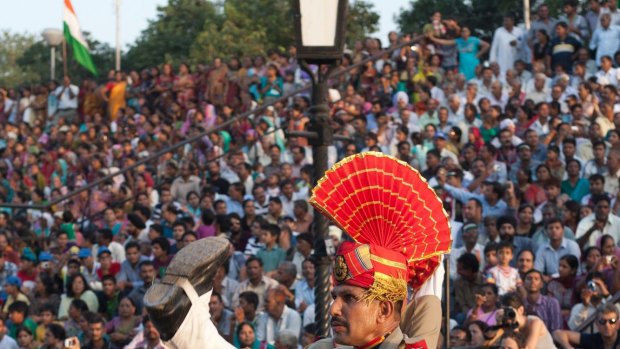
Wagah: Dramatic leg work at the lowering of the colours at the India-Pakistan border.Credit: Alamy
Where: Forecourt of Buckingham Palace. Nearest tube stations are Green Park and St James' Park.
When: From 11:15 a.m., daily April-July, alternate days August-April. Check the schedule on the website.
Tip: In summer, arrive at 9:30 to secure a good position. Best place for photographs is St James' Palace, where the detachment of the Old Guard forms up at 11 a.m. See changing-the-guard.com.
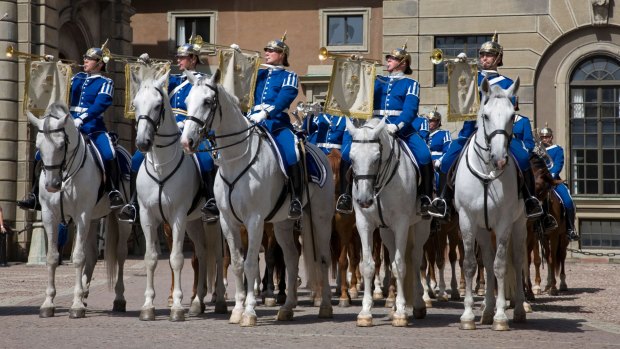
Stockholm: Guards sporting the brilliant blue summer uniform with white trim, and pointed steel helmet.Credit: Alamy
2. Athens, Greece
This is one of the most stylised of all changing of the guard ceremonies and it never fails to raise a few titters from the crowd, but the event is rich with symbolism for Greeks who are rightly proud of it. Wearing a pleated kilt and white leggings, with pompoms attached to their clogs, the two replacement guardsmen mount the steps in front of the tomb, performing a series of stiff-legged, slow motion high kicks and a curious scuffing of their feet. Chosen for their height, moral rectitude and bearing, the soldiers of the Presidential Guard, the Evzones, are known for their courage. During a demonstration in 2001, one of the sentry boxes was engulfed in flames yet the Evzone standing beside it maintained his position until an officer ordered him to move, by which time his uniform was smouldering.
Where: Tomb of the Unknown Soldier, Presidential Mansion, Syntagma Square.
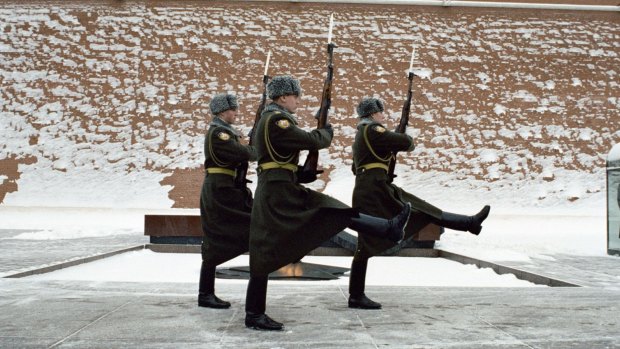
Moscow: Soldiers of the Kremlin Regiment march through the the cold at the Kremlin Wall.Credit: Alamy
When: 11 a.m. Sundays.
Tip: Hang around after the ceremony for a selfie with the guard. See athensinfoguide.com.
3. Wagah, India
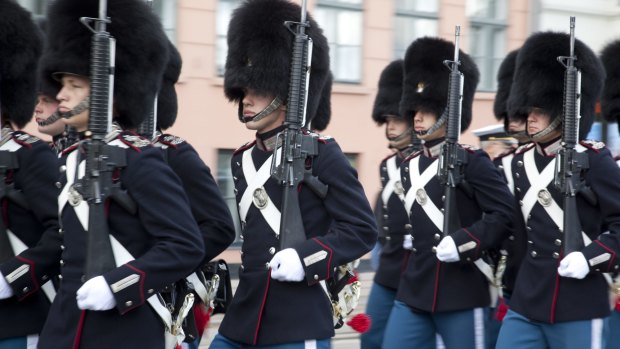
Copenhagen: Changing of the Guard at Amalienborg Palace is a stirring event.Credit: Getty Images
Not strictly speaking a changing of the guard but a ceremonial lowering of the colours that takes place every evening, when the only land crossing between India and Pakistan is closed. It's one of the most ecstatic displays of nationalism you'll ever see. On the Indian side, after an MC warms up the crowd with patriotic chants, a squad of India's Border Security Force marches to the border gate and lowers the flag. The march is more like a charge – four giants in tight formation doing a full-throttle goose step, legs pumping, arms swinging like pendulums gone mad, with a scowl of pure, unblinking hatred fixed on their faces. The Pakistani Rangers meanwhile, are doing the same thing on their side and at the gate they meet. There's a great deal of theatrical stamping, shouting, grimacing and virtual head-butting as the two sides face off at close quarters, as well as a lusty display to which the military phrase "spitting at the enemy" applies. The whole performance is cheered on with vigour by the crowds who pack the stands on either side of the border. What you are seeing is thrillingly dangerous, and hugely symbolic. This is the one place on the planet where two nuclear-armed countries with vast armies and a deep and implacable loathing for one another, divided by history and spurred on by religious fanatics, confront one another over a land border. At this point, all their mutual animosity is distilled into this formalised ritual. It's also hugely cathartic. The mood among the Indians streaming away afterwards is every bit as jubilant as a football crowd whose team has just won the grand final.
Where: Wagah, 32 kilometres from Amritsar.
When: Daily at sunset.
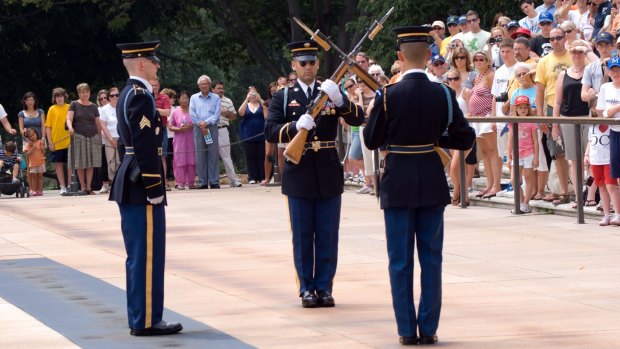
Virginia: The solemn ceremony at Arlington National Cemetery is in conducted regardless of weather.Credit: Alamy
Tip: Best spot is low and close to the gate, with a good view of the Pakistani side of the border. See travel.india.com.
4. Moscow, Russia
This ceremony takes place ever hour, when three soldiers of the Kremlin Regiment march to the plinth with the Tomb of the Unknown Soldier just outside the Kremlin Wall and replace the existing guard. It's simple but smart, the goose-stepping march, the turns timed and executed with metronomic precision. This used to happen at Lenin's Tomb until the practice was ended by President Boris Yeltsin during his crackdown against the legacy of communism. The guards' uniforms were created by Russian fashion designer Valentin Yudashkin, and the winter uniform – a narrow-waisted greatcoat worn with gold brain and high leather boots – is a beauty. According to the Commander of the Kremlin Regiment, during winter, when temperatures can fall to minus 25 degrees, the guardsmen tend to rely on traditional methods to ward off frostbite in their feet: a coating of goose or pork fat.
Where: Alexander Garden, Kremlin.
When: Every hour on the hour.
Tip: Best position is in front of the Eternal Flame. See visitrussia.org.uk.
5. Arlington National Cemetery, USA
Slow and solemn are key in this ceremony which is conducted rain, hail or shine by soldiers of the elite 3rd U.S. Infantry Regiment. The ceremony begins when the relief commander marches to the front of the tomb and announces the Changing of the Guard. Wearing white gloves, he then marches to where the new sentinel is standing and carries out a detailed inspection of his – or her – M14. This is the highlight as the white-gloved commander spins the weapon, running white-gloved hands over it, opening the bolt and checking the chamber, the firing mechanism and the bayonet. The soldiers then march to the front of the tomb, present arms twice and the replacement sentinel takes up position. This is one of the few guard-change ceremonies in which the soldiers are issued with regulation sunglasses to avoid being dazzled by the white marble of the tomb and its surrounds.
Where: Arlington, Virginia.
When: October 1 to March 31 every hour on the hour 8 a.m.-5 p.m., plus every half hour rest of the year, 8 a.m. to 7 p.m..
Tip: Try for a position close to where the weapon inspection takes place, on the far right as you face the tomb. See arlingtoncemetery.mil.
6. Copenhagen, Denmark
Set against the backdrop of Amalienborg Palace, one of the wonders of 18th century Scandinavian rococco architecture, the daily changing of the guard is a stirring event. The uniforms of the Royal Danish Life Guards are brilliant and there's a friendly, common touch about the ceremony as there is about the Danish royal family themselves, whose Crown Princess was formerly Mary Donaldson of Hobart. The ceremony is at its best for the king's watch, one of three watches, which takes place when Her Majesty the Queen is in residence in Christian IX's Palace. During the king's watch the military formation is larger and the guardsmen are accompanied by the Royal Guards music band and the Danish flag, the oldest national flag in the world.
Where: Amalienborg Palace, Copenhagen.
When: Daily at noon.Tip Best viewpoint is from near the equestrian statue. See visitcopenhagen.com.
7. Stockholm, Sweden
There are summer and winter versions of the daily changing of the guard at Stockholm's Royal Palace, but it's the summer event, between April 23 and August 31, that draws the crowds. Wearing their brilliant blue summer uniform with white trim, worn with a pointy Pickelhaube steel helmet and high leather boots, the guards assemble in the forecourt of the official residence of King Carl XVI, the biggest palace in the world still used by a head of state. There's lots of shouting, a military band most days and horses, and look for the women in the ranks. From time to time, summer visitors will see the changing of the guard performed by the mounted Royal Dragoons.
Where: Outer courtyard, Stockholm Royal Palace.
When: 23 April-31 August, Mon-Sat 12:15 p.m., Sundays 1:15 p.m. 1 Sept-22 April, Wednesday, Saturday 12:15 p.m., Sundays 1:15 p.m..
Insider: Get in early or you might only see heads. See stockholmgamlastan.se.
8. Madrid, Spain
The Changing of the Guard that takes place every Wednesday at the Royal Palace is worth a look if you happen to be passing, but the Relevo Solemne on the first Wednesday of most months justifies a long trip. Wearing gorgeous military uniforms with mirror-finish breastplates, plumed helmets and white breeches, more than 400 guardsmen and women and 100 horses mount a ceremonial parade. It's military pomp with a Latin flavour, with flamboyant uniforms, lancers and fluttering pennants that recall the glory days of Imperial Spain.
Where: Royal Palace, Puerta del Príncipe.
When: Every Wednesday from 11 a.m. to 2 p.m, main event first Sunday of the month at 12 midday except July to September.
Tip: Take the guided tour for background information and best position, starting from the Plaza Mayor Tourist Centre at 10am. See turismomadrid.es.
9. Prague
The changing of the guard at Prague Castle takes place every hour during the day, but the best time to see it is for the flag ceremony, daily at midday. It's a no-nonsense business, in keeping with the Czech national character. The Castle Guards march into the courtyard and exchange flags while a band plays. The Guards also provide ceremonial and security duties for the Czech President. Among other requirements, they must be between 1.78 and 1.88 meters in height, and have no tattoos, piercings, earrings or facial hair.
Where: Prague Castle.
When: Every hour on the hour from 7 a.m. to 8 p.m. in summer and 7 a.m. to 6 p.m. in winter.
Tip: The first courtyard is where you need to be for the best views, arrive 30 minutes early. See praguecityline.com.
10. Vatican, Rome
The renaissance-inspired dress uniform of the Swiss Guards is one of the most colourful of any military unit, featuring puffed sleeves and enormous pantaloons in blue, red, orange and yellow and a floppy beret. The midday changing of the guard at the Vatican is brief and almost casual, but well worth seeing for the uniforms alone. Originally a corps of Swiss mercenaries, one of many that served in European armies, the Swiss Guard have been protecting the pope since 1506. Guards must have undergone military training in the Swiss army, must be Catholic, single and every year they renew their oath of allegiance to the pope. Just like the Roman Catholic priesthood, only men may serve as Swiss Guards.
Where: The Arch of Bells, on the left side of St Peter's Basilica as you face the church.
When: Daily at noon.
Tip: Latecomers won't be permitted to enter the archway. See vatican.va.
Sign up for the Traveller Deals newsletter
Get exclusive travel deals delivered straight to your inbox. Sign up now.